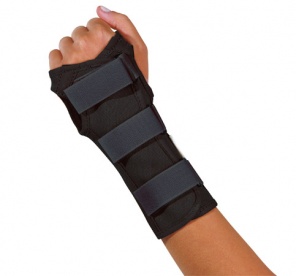Questions and Answers About Repetitive Strain Injury - RSI
6,575 viewsThe intensive use of computers may cause some accidental injury? Typing presents ongoing problem for our body? We can use any type of chair in our workstation? How far should I put my monitor? A digit or digits must have a working differently? These are some questions that this article will try to answer to you.

These questions are very common, for this reason we intend to give some clarification to help those interested in solving their problems.
Computer x Typewriter
The computers perform wonders in our lives. The sophistication of computers allows us to make every day an increasing number of tasks without the need for change in activity, location or position. We enter a long text for hours, just doing facial and hand movements. These movements, however, have one characteristic, they are repetitive, precise, and limited to only a few systems while maintaining muscle in a static position most of the muscle systems of the human body.
Previously, a typing to enter text, and repetitive movements, performed a series of “stops” that interrupted the sequence of these movements. These stops were made to: return the car engine, replace paper, correct mistakes and file copies in their files. Today all this is done in the computer and without any stop or change of position.
The effectiveness and ease with computers have achieved a return for which the human body was not well “designed” that is, the performance of repetitive muscle activity, and must continue for long periods.
Repetitive Strain Injury (RSI)
It is called Repetitive Strain Injury or RSI simply, the injury caused by repetitive activity and performance continues, such as playing the piano, driving trucks, crochet, typing etc.. In practice it is an “accident”, and the resulting disease can be characterized with different names such as carpal tunnel syndrome, tendonitis, tenosynovitis, etc.. Some authors refer to cumulative trauma injury as a synonym for RSI.
The RSI is an injury related to the activities of the person, and in some cases can be understood as an occupational disease, and occurs whenever there is an incompatibility between the requirements of physical activity or task and the physical capacity of the human body. Certain risk factors also contribute to this injury, including: repetitive movements, pulling, poor posture, lifting weights, etc..
The RSI, settles slowly into the human body and often goes unnoticed throughout a working life and when it is perceived there is already a severe impairment of the affected area.
Intesive typing is one of the most common and the incidence of RSI is what has most contributed to the increase in the number of cases of occupational diseases. In the United States in 1978 there were 20,000 cases and these cases in 1990 totaled 185,000.
Prevention of RSI
Human Engineering and Ergonomics is the science that takes care of the adaptation or adjustment to the environment (work or leisure) psychophysiological characteristics or particularities of the human body.
The results of ergonomic studies is that they allow the preparation of projects and adoption of appropriate measures to prevent the man expose their health to perform activities necessary for their livelihood or recreation.
System Man - Machine is generally defined as the combination of operating one or more men with one or more of equipment, interacting in such a way to perform a desired function, from input stimuli, under conditions of a given environment. As an example we can consider a person operating a computer, where, receiving “inputs” of the monitor, you’re sitting in the chair, telephone, position your feet, temperature and noise level of the environment, etc.., Decide and react in order to perform actions on the keyboard or CPU to be performed the required task (output).
Human Factors human organism has unique characteristics that must be taken into consideration in the design of systems for their use. These factors can be classified into:
psychological - learning ability, behavior change, motivation, anxiety, stress, ability to develop habits, etc.;
physiological - eyesight, hearing, length of arms and legs, muscle limitations, sensitivity to heat and cold, etc..
The precautionary measures to avoid RSI are from ergonomic studies, and are not necessarily complex and expensive solutions, in reality often complex studies generate simple and effective solutions. In some cases it is necessary to redesign the work environment to ensure the elimination of risks.
